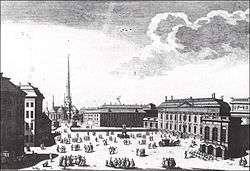House of Nobility (Sweden)

The House of Nobility (Swedish: Riddarhuset) in Stockholm, Sweden, is a corporation and a building, that maintains records and acts as an interest group on behalf of the Swedish nobility.
Name
The name is literally translated as House of Knights, as the knights (Swedish: riddare) belong to the higher ranks of the Swedish nobility, sometimes also together with titles as count (Swedish: Greve) and baron (Swedish: friherre). All esquires are also represented in the corporation (most of the families, so called untitled nobility, Swedish: obetitlad adel). This is a tradition from the Middle Ages when Sweden during the Kalmar Union only had one knight: Sten Sture.
History
Between the 17th and the 19th century the House of Nobility was a chamber in the Estates of the realm, and as such, a Swedish equivalent to the British House of Lords.
In the 18th century, the building was often used for public concerts. From 1731, public concerts were performed here by Kungliga Hovkapellet. Elisabeth Olin is believed to have debuted here in the 1750s, and foreign artists performed such as Elisabetta Almerighi, Giovanni Ansani (1772) and Rosa Scarlatti.
After 1866, when the old Parliament of the Estates was replaced by the new Parliament of Sweden, the Swedish House of Nobility served as a quasi-official representative body for the Swedish nobility, regulated by the Swedish government. Since 2003, it has been a private institution which maintains records and acts as an interest group on behalf of the Swedish nobility, its main purpose being to maintain old traditions and culture.
Building
The Riddarhuset is also the name of the building maintained by the corporation in Stockholm old town. The French-born architect Simon De la Vallée started the planning of the building, but was killed by a Swedish nobleman in 1642. The plans were eventually finished by his son, Jean De la Vallée, in 1660.
The south end of the building carries the Latin inscription CLARIS MAIORUM EXEMPLIS, after the clear example of the forefathers, and holds a statue of Gustav Vasa. North of the building is a park in which is a statue of Axel Oxenstierna.
The architecture of the old main library in Turku, Finland, was influenced by the Swedish House of Nobility.
Gallery
.png) Swedish House of Nobility in 1885
Swedish House of Nobility in 1885 Swedish House of Nobility during the Age of Liberty, in the 18th century.
Swedish House of Nobility during the Age of Liberty, in the 18th century. The Swedish House of Nobility, north end, with a statue of Axel Oxenstierna.
The Swedish House of Nobility, north end, with a statue of Axel Oxenstierna.
See also
- List of Swedish noble families
- Finnish House of Nobility
- Riddarhustorget
- Riddarholmen
- Ointroducerad Adels Förening
External links
| Wikimedia Commons has media related to Riddarhuset. |
- Riddarhuset - Official site
- www.riddarhuset.se
Coordinates: 59°19′33″N 18°03′55″E / 59.32583°N 18.06528°E